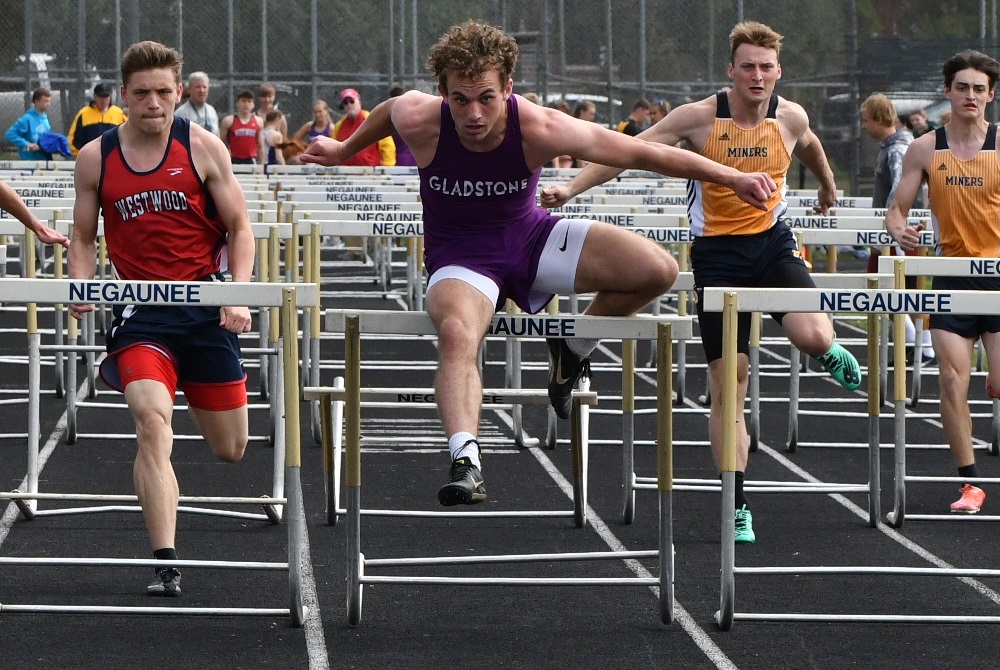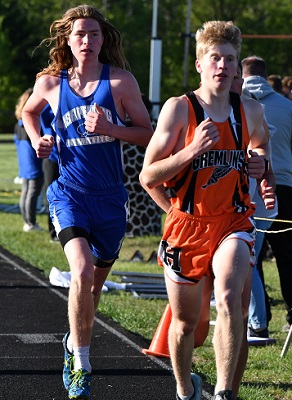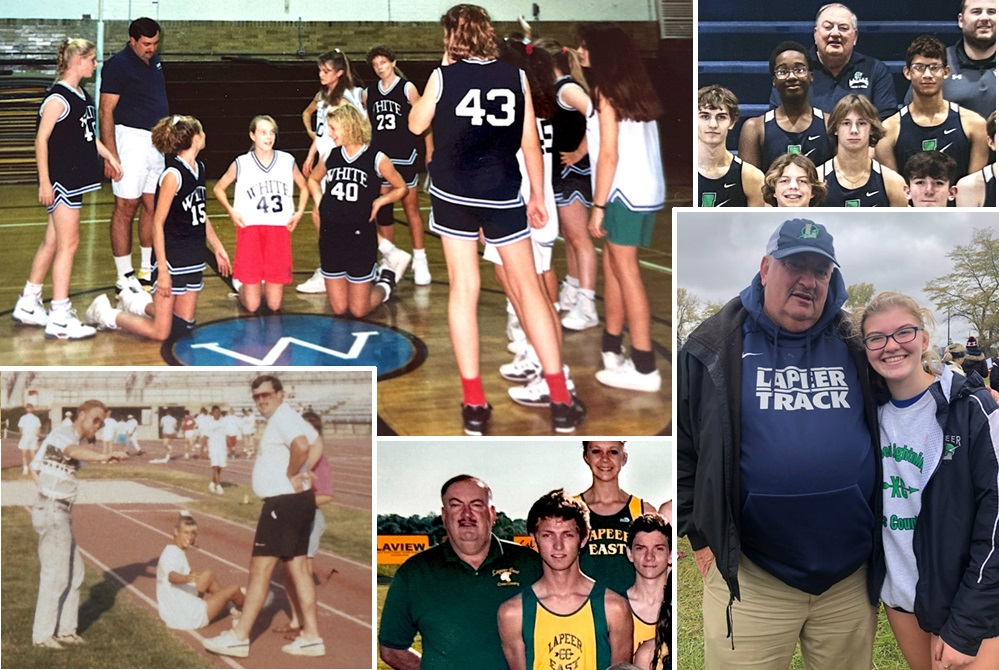
Preview: Past Champs Return to UP Boys Track & Field Finals
By
Geoff Kimmerly
MHSAA.com senior editor
June 4, 2021
Nearly two calendar years have passed the last Upper Peninsula Boys Track & Field Finals.
But three past individual champions will return Saturday with opportunities to add to career achievements first built up before COVID-19 led to the cancelation of last season.
Gladstone’s Blake Servant and Calvin Thibault and Gwinn’s David Duvall all have won at least one Finals title and will be among those to watch as all three divisions again will be competed at Kingsford High School.
Events begin at 10 a.m. (EDT) and tickets to attend can be purchased online only at GoFan. The meets also will be broadcast on MHSAA.tv and viewable with subscription.
Below is a glance at team contenders and individuals to watch in all three divisions.
Division 1
Top Regional scores: Marquette 71, Houghton 70, Gladstone 60.
Team forecast: Gladstone is the reigning champion after a 2019 run where it broke Marquette’s previous four-year hold on the Division 1 title. But Marquette may be the team to chase again with top seeds in two relays, four individual races and shot put. Houghton was runner-up in 2018 and 2016 and is seeking its first championship since 1992. The Gremlins got three individual championships and a leg of a relay winner from junior Eric Weiss at their Regional, and he could be important stacking up in the distance races. Gladstone’s star hurdlers also should factor into the team title mix.
Derek Douglas, Escanaba: The now-senior was fourth in the 800 and ran on three relays at the 2019 Final, and at this year’s Regional he won the 800 (2:01.73) by more than a second and was second in the 400.
Brady Schultz, Menominee: The Maroons junior high-jumped 6-foot-6 at his Regional to win by two inches, and a repeat of that jump would set the UPD1 Finals record by an inch.
Blake Servant, Gladstone: The discus champion as a sophomore in 2019, he may be in line for much more after outpacing two-time reigning Finals champ and teammate Calvin Thibault (see below) in the 110 (15.98) and 300 hurdles (41.9) at the Regional in addition to winning discus (136-9) and long jump (20-8).
Calvin Thibault, Gladstone: Now a senior, Thibault won the 110 and 300 hurdles Finals championships as both a freshman and sophomore, and in addition to Regional runner-up finishes in those races two weeks ago also took third in the 200 and fourth in the 100.
Carson & Colin Vanderschaaf, Marquette: After finishing third and fifth, respectively, in UPD1 cross country in the fall, Marquette’s sophomore distance standouts could be climbing the podium. Carson has the fastest seed times in the 3,200 (10:14.24) and as part of the 3,200 relay (8:45.36). Colin also runs on that 3,200 relay and is seeded first in the 1,600 (4:38.98).
Division 2
Top Regional scores: Iron Mountain 63, Norway 53½, Ishpeming 39.
Team forecast: Ishpeming won back-to-back team championships in 2018 and 2019 and has earned five over the last six seasons, but that streak could be coming to an end as Iron Mountain seeks its first title since 2000 and Norway its first since 2005. Norway could be in line for some big points with the top seeds in two field events, two relays and two individual races. Iron Mountain, however, has an advantage on depth with all four relays and 17 individual entries competing. Ishpeming is right behind with all four relays and 14 individual entries.
Silas Broberg, Ishpeming: The Division 2 cross country champion in the fall will attempt to cap his high school career with another title or more, entering as the top seed in the 3,200 (11:23.9) by 18 seconds while also running the 800, 1,600 and on the 3,200 relay.
 Adam Cavagnetto, Norway: The junior distance standout enters the weekend as the top-seeded contender in both the 800 (2:10.85) and 1,600 (4:46.47).
Adam Cavagnetto, Norway: The junior distance standout enters the weekend as the top-seeded contender in both the 800 (2:10.85) and 1,600 (4:46.47).
David Duvall, Gwinn: He was one of the most impressive performers as a sophomore in 2019, winning the 110 hurdles and finishing runner-up in the 300 and long jump. He’ll be a contender in those three events and as part of the 400 relay, with his 18.16 seed time in the 110 pacing the field.
Christian Koiveniemi, St. Ignace: After running two Finals relays as a freshman in 2019, he’s back as a junior with the top seeds in the 100 (12.08) and 200 (24.77) and also the high jump (5-6).
Landon Sudelius, West Iron County: He took sixth in both hurdles races two years ago as a freshman, but enters this weekend seeded first in the 300 (45.36) and second in the 110.
Division 3
Top Regional scores: Pickford 73, Stephenson 65, Rapid River 64.
Team forecast: Rapid River has had the most recent success of the teams listed above, with two titles and two runner-up finishes between 2015-18 and a fourth place in 2019. Dominant field events would be the Rockets’ ticket this time, while Pickford has some likely high scorers throughout the lineup. Stephenson could be in line for its first team title since 2007 with 23 individual entries and all four relays running including two that are top-seeded. Powers North Central finished only three points behind Stephenson at their Regional and also has some interesting high-scoring possibilities.
Cameron Hoornstra, Brimley: After running the 800 and 1,600 two years ago as a sophomore, Hoornstra has found his stride in the sprints and enters this weekend with the top seed in the 100 (12.0) and fourth in the 200, and he’ll also run the 400 and is fourth-seeded in the long jump.
Kolson Kytta, Chassell: The Division 3 cross country runner-up in the fall could end his Chassell career as a champion entering this weekend with the top seeds in the 1,600 (4:39.17) and 3,200 (10:36.52).
Conner LeClaire, Dollar Bay: He got on the board with a fifth-place finish in the 300 hurdles in 2019 and returns as a senior with the top seed time in that race (43.85) and third-fastest in the 110.
Ben & Max Lenaker, Rapid River: The senior twins both are top seeds in field events, with Ben’s 20-9 pacing long jump and Max’s 6-0 tops in high jump. Ben also is top-seeded in the 400 (52.80) by more than a second.
PHOTOS: (Top) Gladstone's Blake Servant earns one of his four championships during the Mid-Peninsula Conference meet May 24 in Negaunee. (Middle) Houghton's Eric Weiss wins the 3,200 at the Mid-Peninsula finals with Ishpeming's Silas Broberg taking second. (Photos by Cara Kamps.)

'Lapeer Through and Through,' Schmidt Surpasses Half-Century in Coaching
By
Paul Costanzo
Special for MHSAA.com
April 2, 2025
Manny Schmidt still wants to be at track practice.
 After 50-plus years coaching in Lapeer, the man they call Coach Manny has not lost his love for helping student-athletes – and at this rate, he might go another 50.
After 50-plus years coaching in Lapeer, the man they call Coach Manny has not lost his love for helping student-athletes – and at this rate, he might go another 50.
“I told my wife years ago that the first day I don’t feel like going to practice, that I’d rather be somewhere else, that’s the day I’m done,” Schmidt said. “And it hasn’t happened yet. Obviously, you have bad days and things like that. But track, and right now practice, it just keeps me going.”
Schmidt, who is the head boys track & field coach at Lapeer, began coaching track as an assistant in 1974, and has remained there – and Lapeer East, then back at Lapeer when the schools merged back together – ever since. On Friday, April 11, he will be honored at an event at Lightning Rounds in Lapeer for his years of service to Lapeer athletes. The event begins at 7:30 p.m., following the Lapeer Lightning Co-Ed Relays.
“Manny has been a staple of Lapeer Athletics through many different renditions over the years,” Lapeer athletic director Shad Spilski said. “His willingness to help student-athletes grow and achieve their goals is all he wants out of his athletes. Manny spends, and has spent, countless hours over several decades providing athletes multiple opportunities to hone their skills. He not only coaches, but he is one of Lapeer athletes’ biggest fans and supporters. You will always find him at other sporting events cheering on athletes and his coaching colleagues. He truly is Lapeer through and through.”
Schmidt came to Lapeer to teach English in December of 1972 after graduating from Western Michigan University. He had attended high school at St. Joseph Catholic, and was unfamiliar with Lapeer.
But it didn’t take long for him to fall in love with the school community after receiving the assignment.
“Almost immediately,” he said. “I started in December; the teacher had left and I got the job in December. Three days later, they had a staff Christmas party that I got invited to, and all of my close friends over the years, many of them, I guess, I met at that party.”
Coaching was always something Schmidt wanted to do. He played basketball and ran track in high school, and had a basketball coach who made a big impact on his life. He wanted to do the same for others.
In the spring of 1974, during his first full year of teaching English at Lapeer, he got that chance as the assistant track coach. He has since coached cross country – working to start the Lapeer East girls program in the 1990s – junior varsity football and middle school basketball. He also served as a basketball official for more than 30 years.
“I just liked being part of it,” he said.
 Throughout his five decades coaching track, Schmidt has worked with athletes in every event. While middle and long distance are what he’s long enjoyed coaching, he’s currently working with the Lapeer throwers and high jumpers, as head cross country coaches Russ Reitz and Bill Spruytte are also coaching track.
Throughout his five decades coaching track, Schmidt has worked with athletes in every event. While middle and long distance are what he’s long enjoyed coaching, he’s currently working with the Lapeer throwers and high jumpers, as head cross country coaches Russ Reitz and Bill Spruytte are also coaching track.
“In our program, we have four of us (Schmidt, Reitz, Spruytte and Anthony Merlo), and we all have equal voice, we all coach together,” Schmidt said. “On any given day, and that’s the nice thing, I could be with anything. I could be with the hurdlers.”
This past year, Schmidt returned to the Lapeer cross country staff as an assistant, saying he was honored that the current coaches respected him enough to call him back.
But for them, it was an honor to have him.
“Working with Manny is like having access to decades of knowledge,” said fellow cross country assistant Christine Cerny. “It is such a privilege to be able to draw from that and learn from that myself. It’s so awesome to be able to coach alongside him after he has coached my kids.”
During his time, Schmidt has coached multiple generations of Lapeer families, including his own. His children Corrinne and Jennifer both ran for him, as did his grandchildren Morgan, Mason and Colton.
And by his side the entire time has been his wife, Val, who worked as a scorekeeper during meets.
“When I started coaching, she would be the person at all our home cross country meets and all our home track meets who sat there and kept track by hand,” Schmidt said. “Probably the happiest person with this new technology is my wife – now she doesn’t have to do it. When we have invites, she’ll do medals and stuff like that.”
Technological changes have been abundant for high school athletes over the past five decades, not just in competition but outside of it. Schmidt recalls returning to Lapeer from away meets and having athletes line up at the school’s two payphones to call their parents.
“Now, when we get back, everyone has called home and their rides are there waiting,” Schmidt said.
Throughout his time, Schmidt has done plenty of winning and coached several athletes who have moved on to compete at the college level. But the relationships he’s created are what he values most.
“Nobody’s luckier than I am with where I taught and where I coached, and who I’ve coached with over the years,” Schmidt said. “You have to look forward to going to work, and I hate to use the word ‘work’ with coaching. It is, I guess. But there’s just so much good with it.”
 Paul Costanzo served as a sportswriter at The Port Huron Times Herald from 2006-15, including three years as lead sportswriter, and prior to that as sports editor at the Hillsdale Daily News from 2005-06. He can be reached at paulcostanzo3@gmail.com with story ideas for Genesee, Lapeer, St. Clair, Sanilac, Huron, Tuscola, Saginaw, Bay, Arenac, Midland and Gladwin counties.
Paul Costanzo served as a sportswriter at The Port Huron Times Herald from 2006-15, including three years as lead sportswriter, and prior to that as sports editor at the Hillsdale Daily News from 2005-06. He can be reached at paulcostanzo3@gmail.com with story ideas for Genesee, Lapeer, St. Clair, Sanilac, Huron, Tuscola, Saginaw, Bay, Arenac, Midland and Gladwin counties.
PHOTOS (Top) Clockwise from the top left: (1) Manny Schmidt (standing, second from left) coaches the Lapeer White Junior High girls basketball team. (2) Schmidt, top middle, takes a photo with Lapeer’s boys track & field team last spring. (3) Schmidt, left, has coached three of his grandchildren including Morgan Turk. (4) Schmidt, far left, takes a photo with the 2011 Lapeer East cross country teams. (5) Schmidt, standing far right, coaches Michelle Brundage during the 1991 Meet of Champions. (Middle) Schmidt looks on during an event. (Photos provided by the Lapeer athletic department.)

